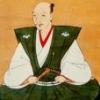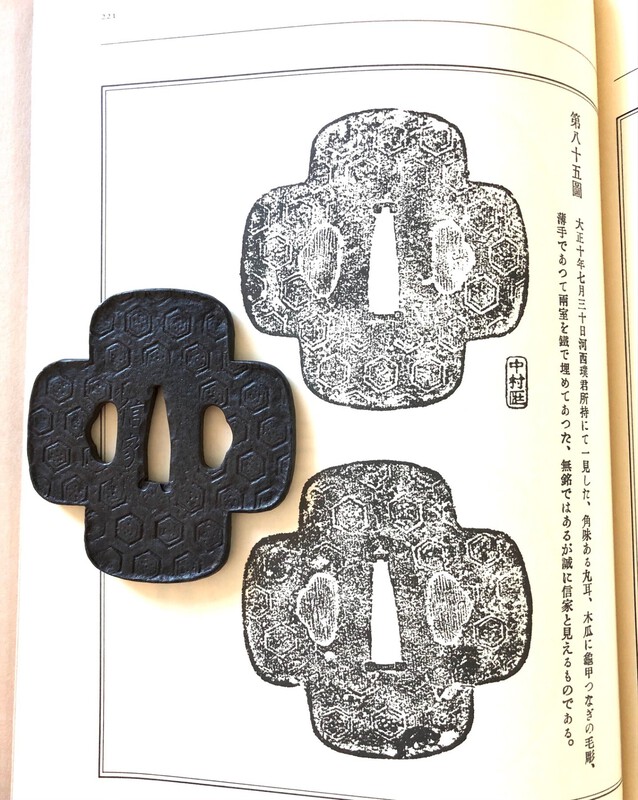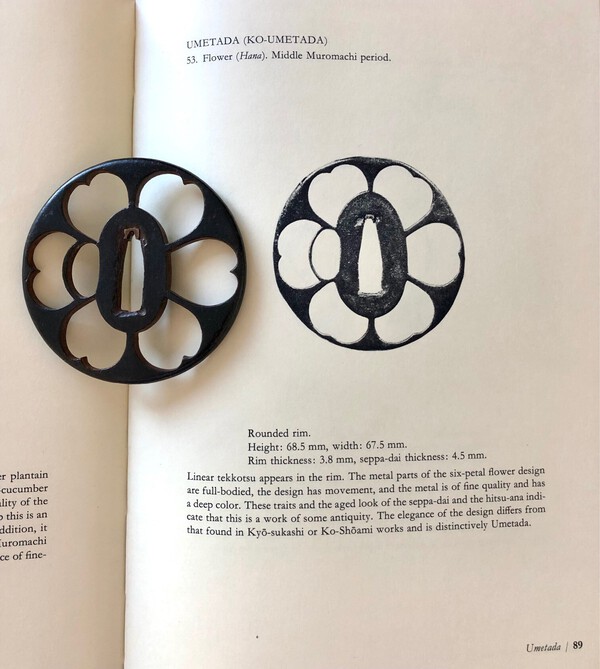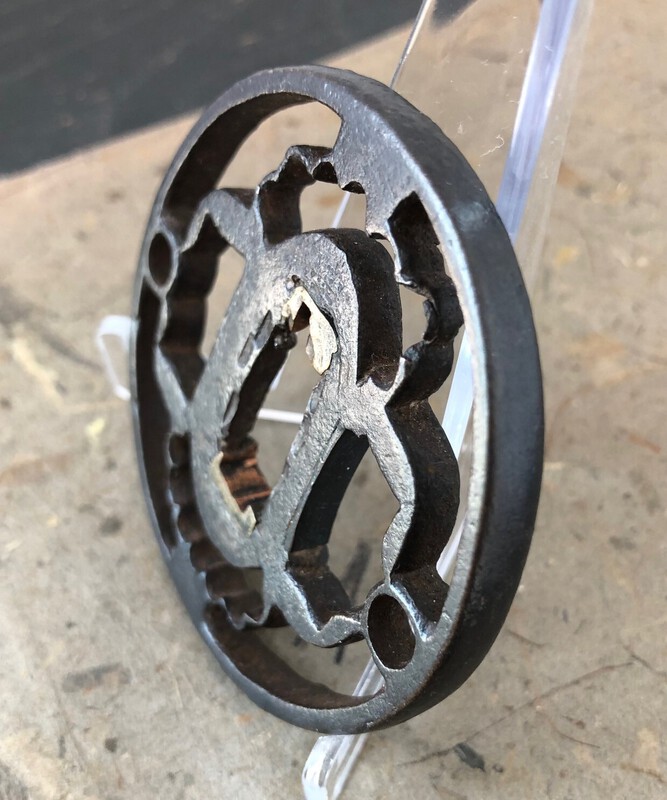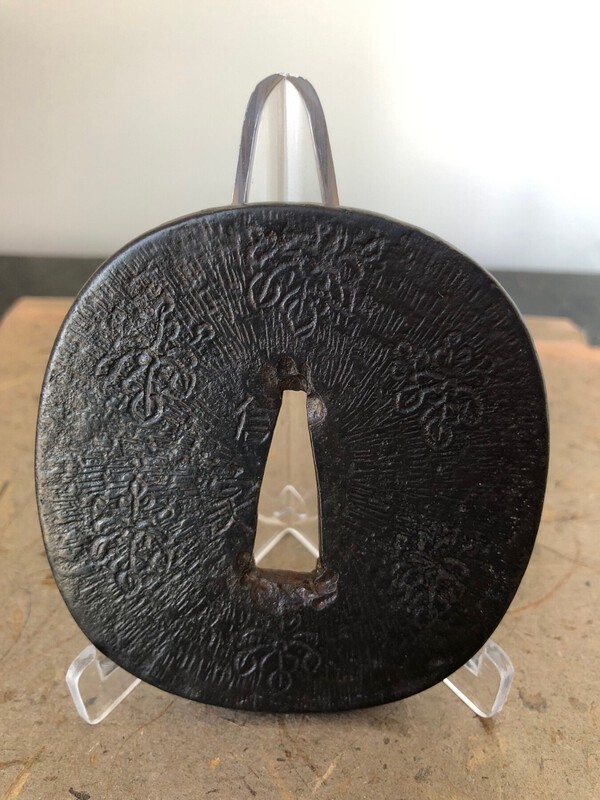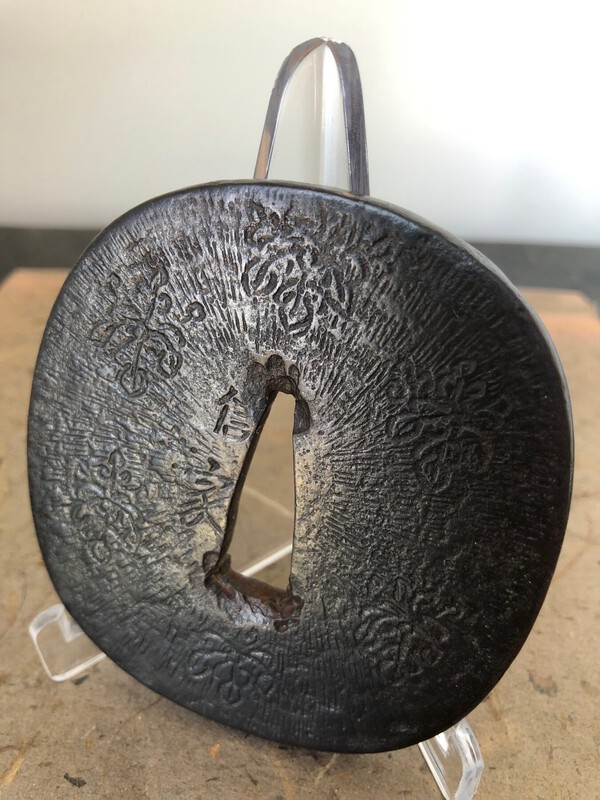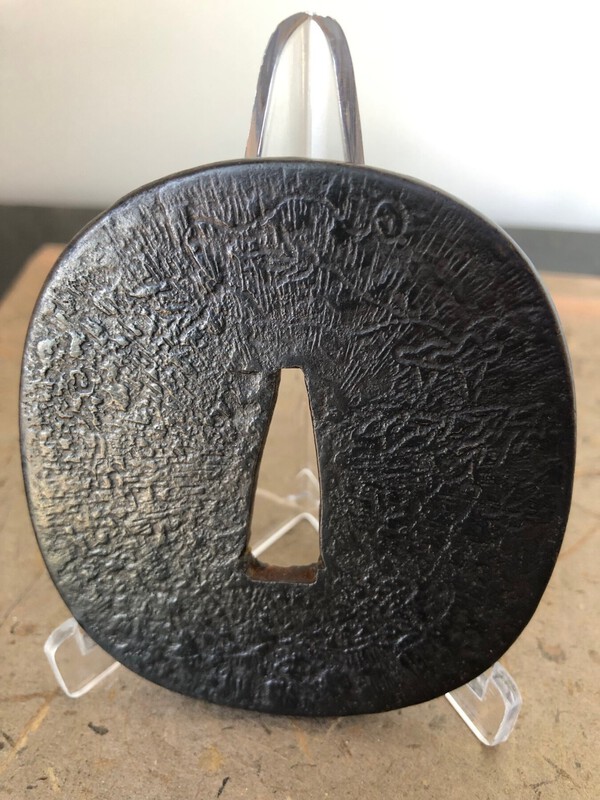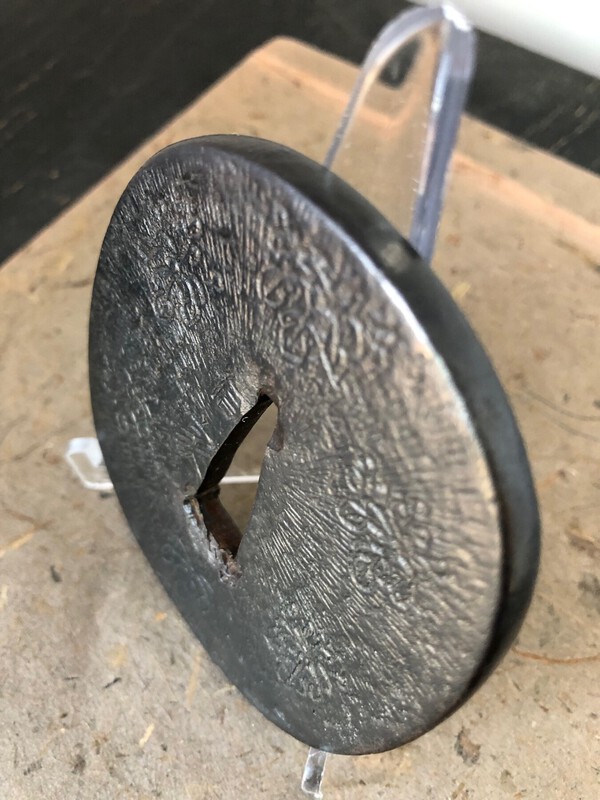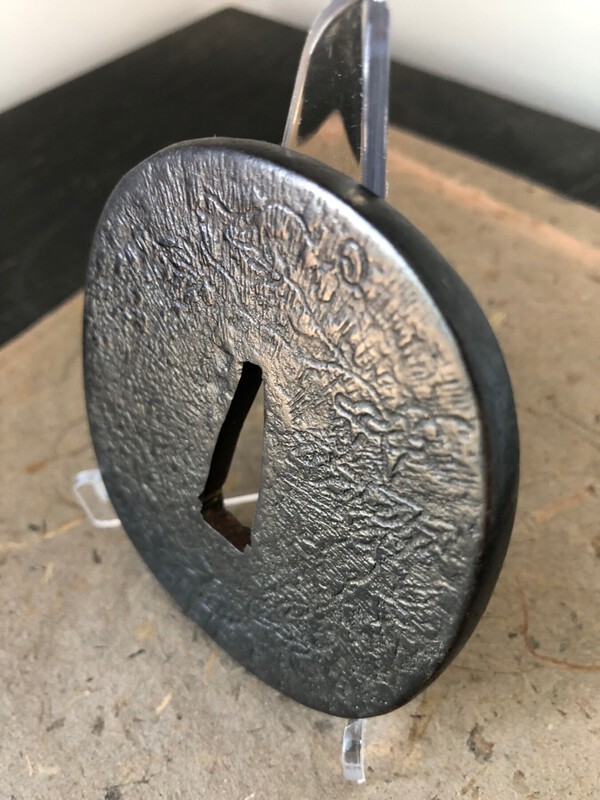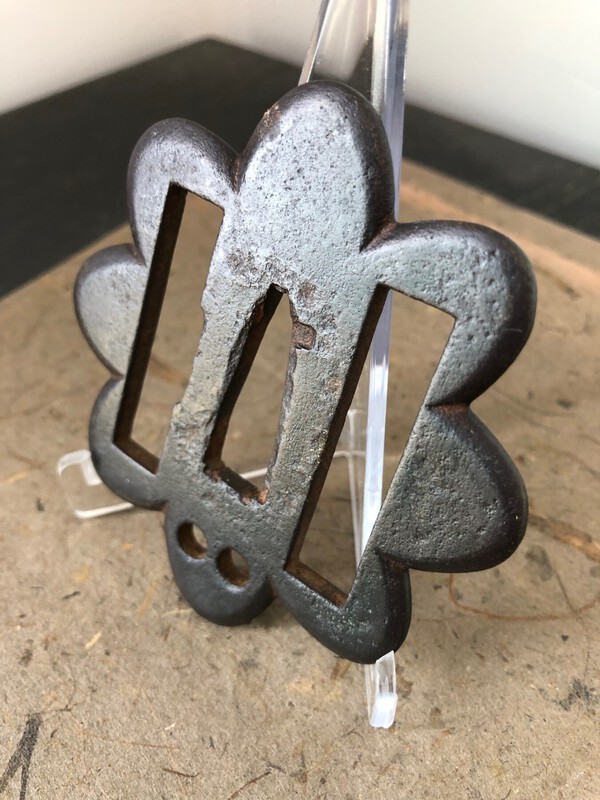-
Posts
961 -
Joined
-
Last visited
-
Days Won
4
Content Type
Profiles
Forums
Events
Store
Downloads
Gallery
Everything posted by Steve Waszak
-
The second of the tsuba is a somewhat smaller, but more robust work in terms of its thickness, measuring 7.65cm x 7.6cm x 5mm. The sukashi openwork features a scalloped design, and so is rather less severe and spartan in its expression than the first example. This piece, too, would suit a Higo koshirae admirably. $550, plus shipping.
-
On offer here are two iron sukashi sword guards. They are clearly works out of the Higo tradition, and may be more immediately tied to the Hirata workshop. These are both deceptively simply pieces, featuring well-worked iron and rather classically Higo expression. I will present photos and dimensions for each tsuba in separate posts. The first piece here measures 8.4cm x 7.95cm x 3mm. It is a relatively large guard, and would be an excellent fit for a Higo koshirae. Ito Mitsuru's fantastic series of books on the four main Higo tsuba traditions -- Hirata, Shimizu, Nishigake, and Hayashi (and Kamiyoshi) -- includes an image of a piece he attributes to Hirata which could be twin of the present work. If a large, spartan, Higo expression is to your liking, this sword guard would fit the bill. $550 plus shipping.
-
Weekend price drop to $875, plus shipping.
-
Offered here is an iron mokko sword guard signed "Nobuie." I do not believe this is the work of either of the two early Nobuie masters. The mei features details that appear to combine characteristics of the signatures of the Shodai and Nidai Nobuie, and the work is clearly expressing the aesthetic sensibilities we associate with the Shodai and Nidai. I believe this dates to the early Edo Period, and could, perhaps, be the product of a Nobuie workshop that had some association with the early smiths. This guard presents with a strong kikko (tortoise-shell) motif done as a pattern over a plate finished in expressive tsuchime. The rim is of uchikaeshi form, as is usual with Nobuie mokko sword guards, and is in excellent condition. Interestingly, there is a very similar work included in the Nobuiye Tsuba Shu, the collection of rubbings of Nobuiye tsuba by Nakamura Kakudaiyu published in the 19th century (see photo of the present tsuba alongside the piece from the Tsuba Shu). The work included by Nakamura is mumei, so no direct mei comparison is possible, but it is clear enough that the aesthetics involved are closely related. Dimensions are 7.9cm x 7.5cm x 5mm at the mimi. $950 plus shipping.
- 1 reply
-
- 6
-

-

-
Excellent find, Peter. Just downloaded the article for reference. Many thanks.
-
Bump, with a final price drop on Tsuba #1, now $425, and Tsuba #2, now $775 (plus shipping). These are really good prices on tsuba of this quality coming out of the Higo tradition.
-
Offered here is a fine iron kuruma-sukashi tsuba, likely dating to the Bakumatsu years of the late-Edo Period. I attribute this sword guard to this time because in the 19th-century, the Bakumatsu era witnessed a strong revivalist sentiment in the area of swords and sword fittings, with several notable smiths working to produce evocative utsushi works echoing the aesthetics of the classic sword guards made in the Momoyama Period by masters in Owari Province (Nobuiye, Yamakichibei, and Hoan). This particular piece is mumei, but absolutely aims to capture the powerful expression of the masterpieces made by those Owari greats in the late 16th and early-17th centuries. This tsuba, too, features a sort of "worm-eaten" texture over the surface of the plate, likely a nod to the Tea Culture sensibilities that dominated the aesthetics of the Momoyama years, where principles such as Sabi, Yugen, Mono no Aware, Wabi, Shubusa, and others were not infrequently manifest in upper-level Buke fittings. I think another, but less likely, possibility is that this tsuba IS of the Momoyama years. The more conservative call here is for a Bakumatsu-Era piece. The condition, color, and patina on the tsuba are excellent. Dimensions are 8cm x 7.5cm x 3mm. $375, plus shipping.
-
- 4
-

-
Sorry, just seeing this now. This tsuba has been SOLD. Thanks for the kinds words once again, Marius!
-
This is a really fine early Umetada iron sword guard. It presents with a floral motif (species of flower unidentified), with a single hitsu-ana for the kozuka. While at first glance a relatively unassuming tsuba, the color, patina, very subtle and deft hammerwork, together with its condition make it an excellent piece. I am moving this only because it doesn't fit in my collecting focus (Owari Province works), as the above features warrant its being a keeper. The color is a deep blue-black, which is not commonly encountered in iron tsuba, where more of a rust-colored iron is the norm. I have included a photo here of the tsuba next to an entry from Sasano's "Early Japanese Sword Guards: Sukashi Tsuba," where he identifies a very similar work (including the nakadaka shape, where the seppa-dai is thicker than the rim), as "Ko-Umetada," and locates that tsuba in the mid-Muromachi Period. I think his dating here is a bit ambitious, but have no problem putting the present piece in the Momoyama Period. This is an elegant, graceful swordguard that I am sorely tempted to keep, despite its not fitting in my collecting focus. Measurements are 7.8cm x 7.7 cm x 6mm at the seppadai, 4.5mm at the rim. $475.
- 4 replies
-
- 13
-

-

-
No problem. I actually have seen papered Yamakichibei (real ones) being auctioned on Yahoo, and have even won a few of these auctions myself. But I have seen some pretty eyebrow-raising NBTHK attributions, so from my experience, papers do not guarantee an accurate call on some of these pieces. I have also seen genuine early Yamakichibei guards without papers in these auctions, along with many, many gimei pieces, needless to say. Unfortunately, it doesn't work to rely on papers to provide 100% accurate attributions on sword guards. I've seen the same tsuba papered to two different makers/schools when it was submitted several years apart. This isn't to cast aspersions at the NBTHK; it's simply to recognize that they are fallible, and so, we have to do our own homework on these things.
-
Gimei, low-quality copy, I'm afraid. Not even close to genuine. Just goes to show the value of these green papers.
-
Tsuba #1 is SOLD.
-
Hi Chris I think you're right. So, let's have a price drop. Tsuba 1 is now $350. Tsuba 2 is now $850.
-
"Yamakichibei," yes, but gimei.
-
It will be available via Lulu.
-
Fully concur. Kudos to Marco for the brilliant effort. It is a huge addition to Tosogu studies.
-
Fans of good early iron should appreciate these two tsuba being offered. Tsuba #1 is a Momoyama Period Owari guard of smaller dimensions (6.8cm x 6.7cm x 4mm) but which features excellent iron, as is characteristic of early Owari work. Subtle tekkotsu complements strong hammerwork. The color of the iron is beautiful, as is the fine patina the tsuba boasts. The motif is a little hard (for me) to identify. The pairs of birds at the top and bottom of the design are often described as wild geese (karigane), but the elements at the left and right represent subjects I am not sure of. The asymmetrical arrangement of these elements creates a sort of "wobble" that was highly appreciated in and mostly peculiar to Momoyama sensibilities. Edo Period Owari works are usually more "perfect" in the symmetry of their designs. This sword guard is centered by a strong, confident seppa-dai, and the nakago-ana is bordered north and south with what appears to be lead sekigane. The price is as low as it is only because of the smaller-than-usual size. $475 plus shipping. Tsuba #2 is a Momoyama Period Kanayama tsuba. The dimensions are 6.4cm x 6.5cm x 5.5/6mm. Such smaller dimensions are the norm for Kanayama works. As is also the norm for Momoyama Kanayama designs, the presentation of the motif is abstracted enough to become difficult to decipher for sure. It is a bold, strong design, however, enhanced by numerous blister-like tekkotsu on the very wide-for-its size rim. This tsuba, too, has a beautiful deep color, and a soft, natural patina. A soft-metal (yamagane/copper) glide has been inserted for the kozuka-ana. This piece exudes the archaic sensibilities expressed so notably in Momoyama Period Kanayama sword guards. Recommended for any Kanayama enthusiasts out there. $950.
-
Weekend price drop! Tsuba #1 is now $500. Tsuba #2 is now $800. "He who hesitates is lost!"
-
Thank you, Brent and Luca. Very happy you're enjoying your new acquisitions.
-
Brilliant, Marco. A wonderful addition. I am now signed up.
-
Tsuba is SOLD.
-
Offered here is a fascinating iron tsuba, signed Nobuie and very much in the vogue of the early masters of this lofty name. I doubt with some confidence that this piece is one actually made by the Nidai Nobuie, though the mei here is quite close to the "Futoji-mei" of the Nidai. The workmanship is excellent, featuring lightly engraved amida-yasuri as a backdrop for the bolder carving of several kiri-mon on the omote, and vines and leaves on the ura. The guard is notable and striking for a few different reasons. One of these is the deep yohkan color tightly associated with Nobuie, and apparently not easy to mimic, as it is not commonly encountered outside of Nobuie work. It is a color highly valued by many Japanese collectors. Additionally, the tsuba is quite thick, at almost/about 6mm, and is heavy in hand. The shape of the sword guard is one that the Nobuie smiths used with some frequency, especially the Nidai, and the fact that the piece is ubu (no hitsu-ana) adds a lot to the presentation of the motif and to the tsuba overall. Yakite work is more pronounced on the ura than on the omote, enhancing the beauty of that side, especially. The color and yakite are complemented by the tsuba's fine, natural patina, and by its excellent condition, as well as by gentlly-expressive tekkotsu in the rim. I think this piece is most likely an early-Edo (pre-1640) work, mostly likely created by a top student in an early-Edo atelier. The details noted above speak to a strong Nidai influence, and the mei is certainly much closer to his than it is to the Shodai's. This is a really good tsuba with a lot of presence, owing to its thickness, weight, color, shape, motif, treatment, and condition. Dimensions are 8cm x 7cm x 5.5 - 6mm. If I'm wrong, and this IS a Nidai Nobuie tsuba, whoever gets it is getting an all-time bargain. If you've ever wanted a real Nobuie-type swordguard but have been put off by the $five-figure prices they command, this is a real chance. *Note: I have no idea if the tsuba has been submitted to shinsa. $1,450, plus shipping.
-
Well, it seems I must have Marius write my sales posts for me! Thanks, Marius. Tsuba is now SOLD.
-
Tsuba #2 This is a beautiful sword guard featuring sukashi of "rays" in addition to gently-incised lines expressing the same. The motif here may be referencing the rays of Amida Buddhism. This tsuba boasts a subtly masterful shape, measuring 8.1cm x 7.9 cm. It is a very thin piece, just 2.5mm at the nakago-ana, and 2mm at the rim. The color and condition of the metal are both excellent. As with the tsuba above, if this, too, is an early example of Hirata Hikozo's iron guards, it is a fortunate find. $900 plus shipping.
-
Offered today are a pair of iron tsuba, both of which have Higo characteristics, and more specifically hint at being from the hand of Hirata Hikozo. It must be remembered that, while he is referred to as a Higo tsubako, Hirata Hikozo lived and worked in Higo province for only some three years, from 1632 to 1635, when he died. So, however long he lived, he spent relatively little time in Higo. His connection to Hosokawa Sansai (the Higo daimyo from 1632 to 1645), however, extends back well earlier than this; it was Sansai who brought Hikozo with him to Higo when he became the daimyo there in 1632. The degree to which Hikozo brought his designs with him to Higo may never be known, but these two tsuba may be examples of his earlier work in iron. Hikozo is much more well known for his incredible works in soft metal, but he is known to have created some pieces in iron; in fact, the only known signed Hikozo tsuba is iron. Tsuba #1: This is an eight-lobed sword guard measuring 8cm x 7.6cm x 4mm at the nakago-ana and 2.5mm at the rim. The nakago-ana on this piece is very large, indicating that it was fitted to a quite a sizable katana. Two extended rectangular sukashi are adjacent to the nakago-ana, and two udenuki-ana are present below it. The lobes are scalloped along the edges to create a beautifully modeled effect. The condition of this tsuba is excellent. There is a small notch cut out of one of the rectangles to accomodate a kuzuka. If this is in fact an early Hikozo work, it is quite the bargain. $650 plus shipping.


